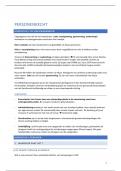College aantekeningen
College aantekeningen Cognitive Neuropsychology (540033-B-6)
- Instelling
- Tilburg University (UVT)
These are lecture notes for the course Cognitive Neuropsychology (-B-6) taken in the year '22/'23 at Tilburg University. The lecture notes contain all lectures except for the guest lecture (lecture 9) which is not mandatory for the exam.
[Meer zien]













